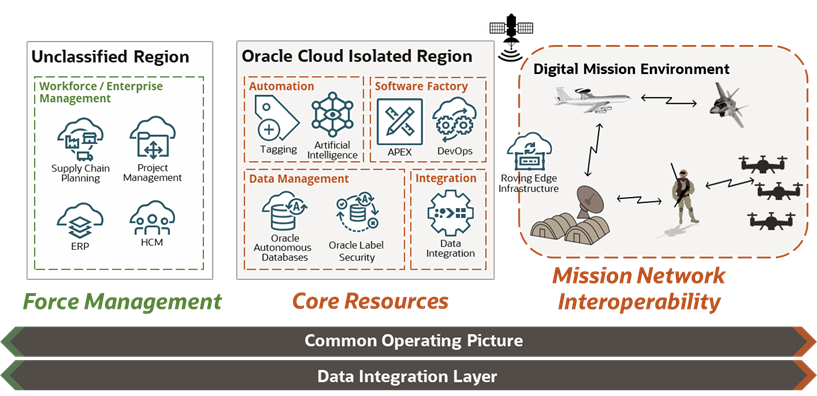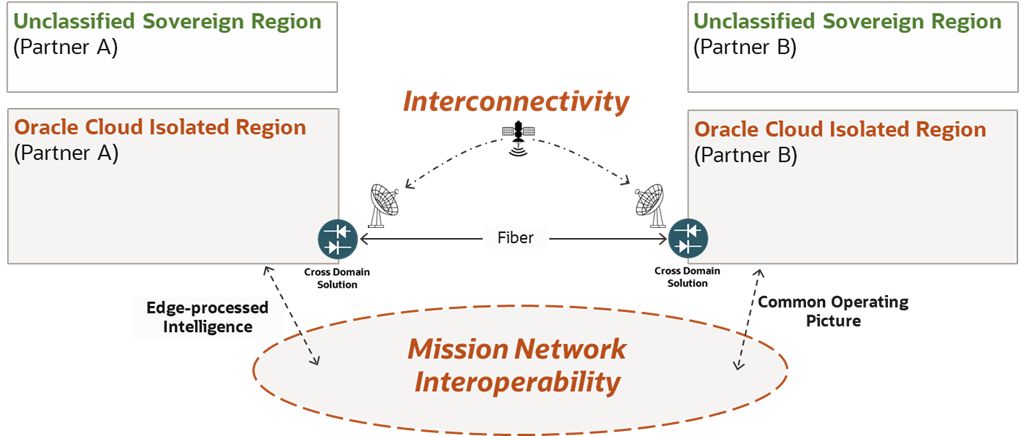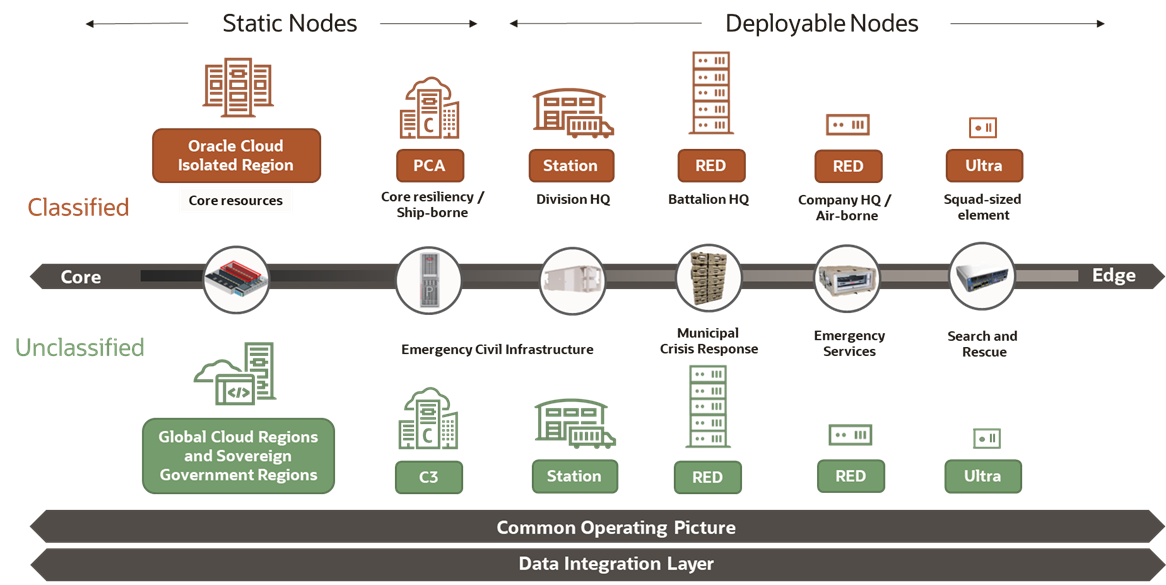Defense agencies globally are increasingly reliant on multi-domain capabilities to make crucial decisions quickly. To preserve the decision-making advantage, alliances such as the North Atlantic Treaty Organization (NATO) and Five Eyes (FVEY) must integrate classified data from all domains within a zero-trust framework.
Current data integration methods are a challenge for timely intelligence sharing and interoperability, especially at the far edge. Legacy information technology (IT) platforms support decades-old vehicles and communications systems. These legacy systems are on different lifecycle timelines, difficult to maintain, and often incompatible with one another. Such outdated data landscapes are counter-productive to common operating pictures, sharing actionable intelligence, and achieving seamless Multi-Domain Operations (MDO) or Combined Joint All-Domain Command and Control (CJADC2).
Modern defense mission command requires:
- Cloud where “cloud” can’t go. Defense and intelligence customers globally need more than a solution with limited infrastructure- and platform-as-a-service (IaaS and PaaS) services, or a solution based on logical isolation and hosting sensitive data in public clouds. Mission owners also seek a full-featured classified cloud, whether on premises or at the far edge, which leverages the same continuous innovation available to commercial customers.
- More from disaggregated IT landscapes. Legacy IT no longer keeps pace with mission demand for global alliances. Years of fragmented IT procurements resulted in data silos that isolate agencies and military departments. Despite limited efforts, achieving MDO and CJADC2 interoperability remains a challenge. Near real-time, hyperscale data integration is key, and relies on a core-to-edge data integration layer.
- Meaningful and actionable insights, faster. Securing, connecting, and managing data is just part of the problem. Alliances need secure access to near real-time data to inform timely decisions. Many manual data integration methods can now be automated in cloud environments.
Cloud deployable at any scale, wherever the mission is

With Oracle’s distributed cloud strategy, defense agencies globally can achieve zero-trust interoperability and mission effectiveness—whether in data centers or remote mission areas with poor connectivity (i.e., disrupted, disconnected, intermittent, or low-bandwidth (DDIL)). Oracle’s goal is to be the world’s most trusted cloud platform, and zero-trust principles are at the core of our products.
Oracle Cloud Infrastructure (OCI) is mission-ready at every US security classification level, including Top Secret. With unclassified government regions in the United States, United Kingdom, Australia, and our EU Sovereign Cloud, Oracle’s range of government cloud products offers defense agencies a data integration layer with complete data sovereignty.
5 data integration solutions with Oracle technology
1. Cross-alliance data integration
The goal of interoperability in CJADC2, MDO, and Federated Mission Networking is to maintain the decision-making advantage. Accurate common operating pictures and sharing actionable intelligence derived from various alliance data sources requires a secure data integration layer. Implementing data integration across all domains and classification levels relies on core-to-edge hyperscale cloud infrastructure. Oracle technology provides this strategic data integration layer at every classification level from core to far-edge, including mission networks, command and control, and sensor nets.
The following figure shows how Oracle technology can interconnect allies—even with integrated satellite communications.

2. On-premises hyperscale classified cloud
Oracle Cloud Isolated Region is Oracle’s air-gapped, hyperscale cloud built for defense missions globally. Combined with Oracle’s integrated Identity and Access Management (IAM) and isolated networking architecture, allies can easily and securely exchange data between respective Isolated Regions.
Global alliances can take advantage of the following Oracle Cloud Isolated Region differentiators:
- Small footprint: Oracle can deliver Oracle Cloud Isolated Region to your on-premises data center, starting as small as approximately 1 megawatt and 100m2 (1,000ft2).
- Data sovereignty: Oracle Cloud Isolated Regions are isolated at the realm level, air-gapped from the internet, and require zero automated data egress. Only dedicated, cleared personnel operate your Isolated Region from in-country facilities that comply to your security standards.
- Rapid deployment: Oracle can build your Oracle Cloud Isolated Region in as few as 12 months from when your data center is whitespace-ready to when cleared personnel take on operations and monitoring. With Oracle’s global expertise in rapidly building cloud regions, Oracle Cloud Isolated Region can accelerate your alliance data strategy.
- Everything Everywhere: Oracle believes that every mission owner’s cloud experience should be identical in classified and unclassified domains. Therefore, Oracle Cloud Isolated Region is more than just a significantly scaled-down subset of IaaS and PaaS services. With Oracle’s Everything Everywhere commitment, the same OCI services in commercial regions are offered in Isolated Regions and maintained at technical parity to accelerate mission systems development and deployment.
- Consistent pricing: OCI service prices are the same across all security classification levels, from public cloud to Oracle Cloud Isolated Region. This means there is no security-budget tradeoff. Mission owners operating on OCI aren’t pressured to run critical workloads in lower classification environments just to preserve budget. Addtionally, any mission owner can use OCI’s public-facing cost estimator to confidently predict workload costs for any mission at any classification level.
3. Strategic artificial intelligence (AI) and machine learning (ML) to maintain the decisive advantage
Modernized mission networks must evolve with AI enablement as a core capability. In the future, alliance intelligence-sharing might involve sharing AI and ML models, where partner assistance with AI and ML could soon be as common as sending physical supplies. Oracle Cloud Isolated Region offers AI and ML services at the classified level. And with Oracle’s NVIDIA partnership, Oracle uniquely offers defense and intelligence customers AI and ML capabilities to use deep learning at scale, and from core to edge, including:
- Federated ML: Allies can securely and collaboratively train a distributed model without physically moving core data. By federating models, alliances can continue generating intelligence in intermittent-connectivity environments—even with non-alliance partners.
- Reduce manual effort, heighten security: Manual crucial intelligence-sharing tasks can now be automated. Alliances must leverage technology to share intelligence faster and more securely, and task developers to the mission.
4. Standardized far-edge IT platforms
Oracle Roving Edge Infrastructure extends cloud to the tactical far edge, empowering mission owners with rapidly scalable edge compute. As devices in the field consume and send more data, interoperable digital ecosystems will require more data integration. By distributing cloud resources closer to the mission, allies can project awareness and enable remote mission owners to make timely decisions.

You can use Roving Edge Infrastructure in several far-edge scenarios:
- Digital linkup: Defense data strategies must enable basic maneuver tasks so that alliance interoperability keeps pace with the speed of mission. For example, overhead aerial systems must seamlessly and securely establish dataflows with allied ground units—regardless of branch or nationality. Oracle’s Roving Edge Device demonstrated in NATO’s largest Unmanned Autonomous Vehicle (UAV) exercise is another example use case.
- Mobile command posts: Deploy your classified cloud from core to far-edge and enable applications in the field even with degraded or nonexistent connectivity. Roving Edge Station is a 25-foot containerized solution with two 42U racks, cooling, power management, UPS, fire suppression, and embedded security monitoring. Battalion-, company-, and squad-level echelons can deploy with Roving Edge Devices or Ultras with powerful data capabilities supporting allied MDOs.
- Joint sensor networks: Alliances must continuously distill big data into actionable intelligence closer to the edge and mission owner. Analyzing shared sensor streams via AI-embedded sensor networks will rely on scalable and deployable platforms. These are essentially cloud-embedded sensor networks.
- Machine-machine interfaces: For example, managing the F-35’s high volume sensor data is possible with Oracle Roving Edge Infrastructure. Additionally, electronic warfare and targeting are growing challenges for alliances, relying on platform agility only possible with cloud at the edge. Drone swarms supporting ground operators will rely on edge AI capabilities to process data in near real-time, independent of connectivity with core resources.
5. Force-multiply your classified mission with Autonomous tech
Alliances must process vast amounts of classified data, both structured and unstructured. As massive data lakes grow alongside a proliferation of global sensors, intelligence production must keep pace with the speed of mission. Oracle Autonomous Database, deployable on Oracle Cloud Isolated Region, uses ML to automate database tuning, security, backups, updates, and other routine management tasks traditionally performed by database administrators (DBAs). With Autonomous Database, your DBAs can be empowered to spend less time on administrative or “keep-the-lights-on” activities, and instead spend more time on achieving greater impact to the mission.
With Oracle Autonomous Database, you can deploy:
- Software at the far edge: Mission owners can use Oracle APEX for rapid, low-code app development to deploy critical tools to the far edge—even mobile devices. Oracle Roving Edge Infrastructure can provide devices a far-edge connection within private networks, without relying on core resource connectivity.
- Spatial analytics: Allies must maintain an accurate common operating picture across all domains to produce and share timely intelligence. Oracle’s spatial database is built for location intelligence analytics and geographic information system (GIS) professionals to rapidly deploy advanced geospatial applications including interactive map visualization tools.
- Low-code Autonomous Database Data Studio: Mission owners can easily load, transform, and build models for use in analytics and securely share data. Intuitive drag-and-drop interfaces help eliminate data silos and easily integrate ad-hoc or unconventional data sources.
- Zero-trust intelligence sharing: Oracle Label Security standardizes security across applications both on premises and the cloud to enforce classification security in multilevel security (MLS) databases. Alliances can integrate Oracle’s policy-governed IAM technology with Oracle Autonomous Database to establish a zero-trust data integration layer between partners and security domains. With near real-time access verifications, alliances can share intelligence at the speed of mission.
Modernize to the next-generation classified cloud today
Accept nothing less than true hyperscale, classified cloud: Oracle Cloud Isolated Region. As a mission owner, you should demand from the industry what you need. Connecting air, cyber, land, maritime, and space domains across all classification levels requires core-to-edge hyperscale cloud. For information about Oracle Cloud’s hands-on workshops, reach out to your account representative.
